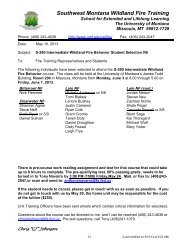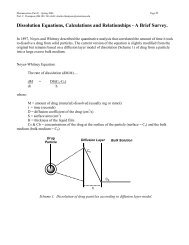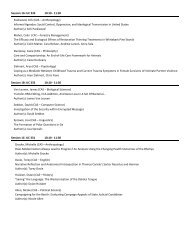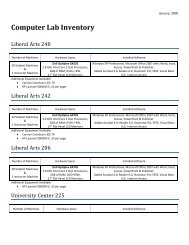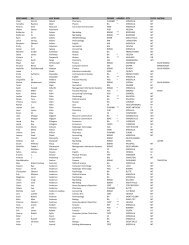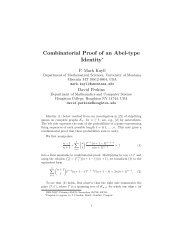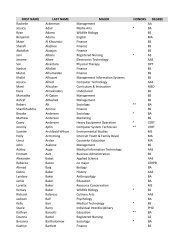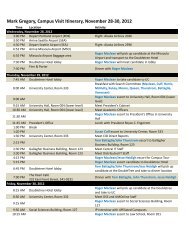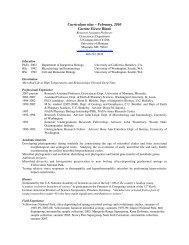You also want an ePaper? Increase the reach of your titles
YUMPU automatically turns print PDFs into web optimized ePapers that Google loves.
UDWPA Questions for June 2012 Exam<br />
QUESTION 1 In her essay, <strong>Kingsolver</strong> argues that we should protect the “the imperfect<br />
lands, the fragments of backyard desert paradise, the creek that runs between farms” and that<br />
protecting these lands is as important as protecting tracts of our “wildest lands.” Do you agree<br />
that these backyard lands are important to preserve? Why or why not?<br />
Write an essay that answers this question with specific reference to <strong>Kingsolver</strong>’s text. Your<br />
essay should include your own defensible thesis statement and reasons and examples from<br />
your studies, experience, or observations that develop and support it.<br />
OR<br />
QUESTION 2. In her essay, <strong>Kingsolver</strong> claims that we need, not only “virgin wilderness” but<br />
also “remnant wilderness,” natural places we interact with on a daily basis, so that we have<br />
places we “always like to think about.” Does having an imaginary refuge require routine<br />
access to backyard lands, as <strong>Kingsolver</strong> suggests?<br />
Write an essay that answers this question with specific reference to <strong>Kingsolver</strong>’s text. Your<br />
essay should include your own defensible thesis statement and reasons and examples from<br />
your studies, experience, or observations that develop and support it.<br />
(Scroll down for April 2010 UDWPA Assessment Text)
THE MEMORY PLACE<br />
<strong>Barbara</strong> <strong>Kingsolver</strong><br />
<strong>The</strong> daughter of a doctor who would accept home-grown vegetables from patients<br />
too poor to pay in cash, <strong>Kingsolver</strong> was born in Annapolis, Maryland, and grew<br />
up in Nicholas County, Kentucky, a rural area where most people earned a<br />
subsistence income <strong>by</strong> farming. She earned degrees in biology from DePauw<br />
University and the University of Arizona, and has worked as a freelance writer<br />
and author since 1985.<br />
This is the kind of April morning no other month can touch: a world<br />
tinted in watercolor pastels of redbud, dogtooth violet, and gentle rain. <strong>The</strong><br />
trees are beginning to shrug off winter; the dark, leggy maple woods are shot<br />
through with gleaming constellations of white dogwood blossoms. <strong>The</strong> road<br />
winds through deep forest near Cumberland Falls, Kentucky, carrying us across<br />
the Cumberland Plateau toward Horse Lick Creek. Camille is quiet beside me<br />
in the front seat, until at last she sighs and says, with a child's poetic logic,<br />
“This reminds me of the place I always like to think about.”<br />
Me too, I tell her. It’s the exact truth. I grew up roaming wooded<br />
hollows like these, though they were more hemmed-in, keeping their secrets<br />
between the wide-open cattle pastures and tobacco fields of Nicholas County,<br />
Kentucky. My brother and sister and I would hoist cane fishing poles over our<br />
shoulders, as if we intended to make ourselves useful, and head out to spend a<br />
Saturday doing nothing of the kind. We haunted places we called the Crawdad<br />
Creek, the Downy Woods (for downy woodpeckers and also for milkweed<br />
fluff), and—thrillingly, because we’d once found big bones there—Dead Horse<br />
Draw. We caught crawfish with nothing but patience and our hands, boiled<br />
them, with wild onions over a campfire, and ate them and declared them the<br />
best food on earth. We collected banana-scented pawpaw fruits, and were<br />
tempted <strong>by</strong> fleshy, fawn-colored mushrooms but left those alone. We watched<br />
birds whose names we didn’t know build nests in trees whose names we<br />
generally did. We witnessed the unfurling of hickory and oak and maple leaves<br />
in the springtime, so tender as to appear nearly edible; we collected them and<br />
pressed them, with a hot iron under waxed paper when they blushed and<br />
dropped in the fall. <strong>The</strong>n we waited again for spring, even more impatiently<br />
than we waited for Christmas, because its gifts were more abundant, needed no<br />
batteries, and somehow seemed more exclusively ours. I can’t imagine that any<br />
discovery I ever make, in the rest of my life, will give me the same electric<br />
thrill I felt when I first found little righteous Jack in his crimson-curtained<br />
pulpit poking up from the base of a rotted log.<br />
<strong>The</strong>se were the adventures of my childhood: tame, I guess, <strong>by</strong> the<br />
standards established <strong>by</strong> Mowgli the Jungle boy or even Laura Ingalls Wilder.<br />
Nevertheless, it was the experience of nature, with its powerful lessons in static<br />
change and predictable surprise. Much of what I know about life, and almost<br />
everything I believe about the way I want to live, was formed in those woods.<br />
In times of acute worry or insomnia or physical pain, when I close my eyes and<br />
bring to mind the place I always like to think about, it looks like the woods in<br />
Kentucky.<br />
Horse Lick Creek is a tributary to the Rockcastle River, which drains<br />
most of eastern Kentucky and has won enough points for beauty and biological<br />
diversity to be s named a "wild river.” <strong>The</strong> Nature Conservancy has chosen<br />
Horse Lick as a place to cherish particularly, and protect. <strong>The</strong> creek itself is 16<br />
miles long, with a watershed of 40,000 acres; of this valley, 8,000 acres belong<br />
to the Forest Service, about 1,500 to the Nature Conservancy, and the<br />
remainder to small farms, whose rich bottoms are given over to tobacco and<br />
hay and com, and whose many steep, untillable slopes are given to forest. <strong>The</strong><br />
people who reside here have few choices about how they will earn a living. If<br />
they are landless, they can work for the school system or county government,<br />
they can commute to a distant city, or they can apply for food stamps. If they<br />
do have land, they are cursed and blessed with farming. It’s rough country.<br />
<strong>The</strong> most lucrative crop that will grow around here is marijuana, and while few<br />
would say they approve, everybody knows it’s the truth.<br />
Sand Gap, the town at the upper end of the valley, is the straggling<br />
remains of an old mining camp. Gapites, as the people of Sand Gap call<br />
themselves, take note of us as we pass through. We’ve met up now with Jim<br />
Hays, the Nature Conservancy employee who oversees this holding and<br />
develops prospects for purchasing other land to improve the integrity of the<br />
preserve. I phoned him in advance and he has been kind enough, on a rainy<br />
morning, to show us the way into the preserve. Camille and I jostle in the cab<br />
of his pickup like pickled eggs in a jar as we take in the territory, bouncing<br />
around blind curves and potholes big enough to swallow at least a good laying<br />
hen. We pass a grocery store with a front porch, and the Pony Lot Holiness<br />
Church. JESUS LOVES YOU, BOND WELCOMES YOU, declares a sign<br />
in another small settlement.
Jim grew up here, and speaks with the same hill cadences and turns of<br />
phrase that shaped my own speech in childhood. Holding tight to the wheel, he<br />
declares, “This is the hatefulest road in about three states. Everybody that lives<br />
on it wrecks." By way of evidence we pass a rusted car, well off the road and<br />
headed down-hollow; its crumpled nose still rests against the tree that ended its<br />
life, though it’s hard to picture how it got there exactly. Between patches of<br />
woods there are pastures, tobacco fields, and houses with mowed yards and<br />
flower gardens and folkloric lawn art. Many a home has a “pouting house” out<br />
back, a tarpaper shack where a person can occasionally seek refuge from the<br />
rest of the family.<br />
Turner’s General Merchandise is the local landmark, meeting place,<br />
and commercial hub. It’s an honest-to-goodness general store, with a plank<br />
floor and a pot-bellied stove, where you can browse the offerings of canned<br />
goods, brooms, onion sets, and more specialized items like overalls and<br />
cemetery wreaths. A pair of hunters come in to register and tag the wild<br />
turkey they’ve killed—the fourth one brought in today. It’s opening day of<br />
turkey season, which will last two and a half weeks or until the allotted<br />
number of carcasses trail in, whichever comes first. If the season was not<br />
strictly controlled, the local turkey population would likely be extinct before<br />
first snowfall.<br />
Nobody, and everybody, around here would say that Horse Lick<br />
Creek is special. It’s a great place to go shoot, drive off-road vehicles, and<br />
camp out. In addition to the wild turkeys, the valley holds less conspicuous<br />
riches: limestone cliffs and caves that shelter insectivorous bats, including the<br />
endangered Indiana bat; shoals in the clear, fast water where many species of<br />
rare mussels hold on for their lives. All of this habitat is threatened <strong>by</strong><br />
abandoned strip mines, herbicide and pesticide use, and literally anything that<br />
muddies the water. So earthy and simple a thing as mud might not seem<br />
hazardous, but in fact it is; fine silt clogs the gills of filter-feeding mussels,<br />
asphyxiates them, and this in turn starves out the organisms that depend on<br />
the filter feeders. Habitat destruction can be more subtle than a clear-cut or a<br />
forest fire; sometimes it’s nearly invisible. Nor is it necessarily ugly. Many<br />
would argue that the monoculture of an Iowa cornfield is more beautiful than<br />
the long-grass prairie that made way for it. But when human encroachment<br />
alters the quality of a place that has supported life in its particular way for<br />
millions of years, the result is death, sure and multifarious. <strong>The</strong> mussels of<br />
Horse Lick evolved in clear streams, not muddy ones, and so some of the<br />
worst offenders here are not giant mining conglomerates but cattle or local<br />
travelers who stir up daily mudstorms in hundreds of spots where the road<br />
crosses the creek. Saving this little slice of life on earth—like most—will take<br />
not just legislation, but change at the level of the pickup truck.<br />
Poverty rarely brings out the most generous human impulses,<br />
especially when it comes to environmental matters. Ask a hungry West<br />
African about the evils of deforestation, or an unemployed Oregon logger<br />
about the endangered spotted owl, and you’ll get just about the same<br />
answer: I can’t afford to think about that right now. Environmentalists must<br />
make a case, again and again, for the possibility that we can’t afford not to<br />
think about it. We point to our wildest lands—the Amazon rain forests, the<br />
Arctic tundra—to inspire humans with the mighty grace of what we haven’t<br />
yet wrecked. Those places have a power that speaks for itself, that seems to<br />
throw its own grandeur as a curse on the defiler. Fell the giant trees, flood<br />
the majestic canyons, and you will have hell and posterity to pay.<br />
But Jackson County, Kentucky, is nobody’s idea of wilderness. I<br />
wonder, as we bounce along: Who will complain, besides the mute mussels<br />
and secretive bats, if we muddy Horse Lick Creek?<br />
Polly and Tom Milt Lakes settled here a hundred years ago, in a<br />
deep hollow above the creek. Polly was the county’s schoolteacher. Tom<br />
Milt liked her looks, so he saved up to buy a geography book, then went to<br />
school and asked her to marry him. Both were in their late teens. <strong>The</strong>y<br />
raised nine children on the banks of Horse Lick. We pass <strong>by</strong> their<br />
homestead, where feral jonquils mark the ghost-boundaries of a front porch<br />
long gone.<br />
<strong>The</strong>ir main visible legacy is the Lakes family cemetery, hidden in a<br />
little glade. Camille and I wander quietly, touching headstones where<br />
seventy or more seasons of rain have eroded the intentions of permanent<br />
remembrance. A lot of babies lie here: Gladys, Colon, and Ollie May Lakes<br />
all died the same day they were born. A pair of twins, Tomie and Tiny,<br />
lived one and two days, respectively. Life has changed almost<br />
unimaginably since the mothers of these children grieved and labored here.<br />
But the place itself seems relatively unaltered—at least at first glance.<br />
It wasn’t a true wilderness even then, but a landscape possessed <strong>by</strong> hunters<br />
and farmers. Only the contents of the wildcat dumps have changed; the one I<br />
stopped earlier to inventory contained a hot-water heater, the headboard of a
wooden bed, an avocado-green toilet, a playpen, and a coffee maker.<br />
We make our way on down the valley. <strong>The</strong> hillside drops steeply away<br />
from the road, so that we’re looking up at stately maple trunks on the left, and<br />
down into their upper branches on the right. <strong>The</strong> forest is unearthly: filtered<br />
light through maple leaves gives a green glow to the creek below us.<br />
Mayapples grow in bright assemblies like crowds of rain-slick umbrellas; red<br />
trilliums and wild ginger nod from the moss-carpeted banks. Ginseng grows<br />
here too—according to Jim, many a young man makes his truck insurance<br />
payments <strong>by</strong> digging “sang.”<br />
Deep in the woods at the bottom of a hollow we find Cool Springs, a<br />
spot where the rocky ground yawns open to reveal a rushing underground<br />
stream. <strong>The</strong> freshet merely surfaces and then runs away again, noisily, under a<br />
deeply undercut limestone cliff. I walk back into the cave as far as I can, to<br />
where the water roars down and away, steep and fast. I can feel the cold slabs<br />
of stone through the soles of my shoes. Turning back to the light, I see sunlit<br />
spray in a bright, wide arc, and the cave’s mouth framed <strong>by</strong> a fringe of backlit<br />
maidenhair ferns.<br />
Farther down the road we find the “swirl hole”—a hidden place in a<br />
rhododendron slick where the underground stream bubbles up again from the<br />
deep. <strong>The</strong> water is nearly icy and incredibly blue as it gushes up from the<br />
bedrock. We sit and watch, surrounded <strong>by</strong> dark rhododendrons and hemlocks,<br />
mesmerized <strong>by</strong> the repetitious swirling of the water. Camille tosses in tiny<br />
hemlock cones; they follow one another in single file along a spiral path,<br />
around and around the swirl hole and finally away, downstream, to where this<br />
clear water joins the opaque stream of Horse Lick Creek itself.<br />
<strong>The</strong> pollution here is noticeable. Upstream we passed wildcat strip<br />
mines, bulldozed flats, and many fords where the road passes through the<br />
creek. <strong>The</strong> traffic we’ve seen on this road is recreational vehicles. At one point<br />
we encountered two stranded young men whose Ford pickup was sunk up to<br />
its doors in what they called a “soup hole,” an enormous pothole full of water<br />
that looked like more fun than it turned out to be. We helped pull them out,<br />
but their engine only choked and coughed muddy water out the tailpipe—not a<br />
good sign. When we left them, they were headed back to town on foot.<br />
When Tom Milt and Polly Lakes farmed and hunted this land, their<br />
lives were ruled <strong>by</strong> an economy that included powerful obligations to the<br />
future. If the land eroded badly, or the turkeys were all killed in one season,<br />
they and their children would not survive. Rarely does any creature have the<br />
luxury of fouling its own nest beyond redemption.<br />
But now this territory is nobody’s nest, exactly. It’s more of a<br />
playground. <strong>The</strong> farmers have mostly gone to the cities for work, and with<br />
their hard-earned wages and leisure time they return with off-road vehicles.<br />
Careless recreation, and a failure of love for the land, are extracting their<br />
pound of flesh from Horse Lick Creek.<br />
A map of this watershed is a jigsaw puzzle of public and private<br />
property. <strong>The</strong> Conservancy’s largest holding lies at the lower end of the<br />
valley. We pass through Forest Service land to get to it, and park just short of<br />
a creek crossing where several tiny tributaries come together. Some of the<br />
streams are stained with iron ore, a deep, clear orange. I lean against the truck<br />
eating my sandwich while Camille stalks the butterflies that tremble in<br />
congregations around the mud puddles—tiger swallowtails. She tries to catch<br />
them with her hands, raising a languid cloud of yellow and black. <strong>The</strong>y settle,<br />
only mildly perturbed, behind us, as we turn toward the creek.<br />
We make our way across a fallow pasture to the tree-lined bank. <strong>The</strong><br />
water here is invisibly clear in the shallows, an inviting blue green in the<br />
deeper, stiller places. We are half a mile downstream from one of the largest<br />
mussel shoals. Camille, a seasoned beachcomber, stalks the shoreline with the<br />
delicate thoroughness of a sandpiper, collecting piles of shells. I’m less thrilled<br />
than she <strong>by</strong> her findings, because I know they’re the remains of a rare and<br />
dying species. <strong>The</strong> Cumberland Plateau is one of the world’s richest sites of<br />
mussel evolution, but mussels are the most threatened group in North America.<br />
Siltation is killing them here, rendering up a daily body count. Unless the<br />
Conservancy acquires some of the key lands where there is heavy creek<br />
crossing, these species will soon graduate from “endangered" to “extinct.”<br />
Along the creekbanks we spot crayfish holes and hear the deep, throaty<br />
clicking of frogs. <strong>The</strong> high bank across from us is a steep mud cliff carved<br />
with round holes and elongated hollows; it looks like a miniature version of<br />
the windswept sandstone canyons I’ve come to know in the West. But<br />
everything here is scaled down, small and humane, sized for child adventures<br />
like those I pursued with tireless enthusiasm three decades ago. <strong>The</strong> hay fields<br />
beyond these woods, the hawk circling against a mackerel sky, the voices of<br />
frogs, the smells of mud and leaf mold, these things place me square in the<br />
middle of all my childhood memories.<br />
I recognize, exactly, Camille’s wide-eyed thrill when we discover a<br />
trail of deer tracks in the soft mud among bird-foot violets. She kneels to
examine a cluster of fern fiddleheads the size of her own fist, and is startled <strong>by</strong><br />
a mourning cloak butterfly (which, until I learned to read field guides, I<br />
understood as “morning cloak”). Someone in my childhood gave me the<br />
impression that fiddleheads and mourning cloaks were rare and precious. Now<br />
I realize they are fairly ordinary members of eastern woodland fauna and flora,<br />
but I still feel lucky and even virtuous—a gifted observer—when I see them.<br />
For that matter, they probably are rare, in the scope of human<br />
experience. A great many people will live out their days without ever seeing<br />
such sights, or if they do, never gasping. My parents taught me this—to gasp,<br />
and feel lucky. <strong>The</strong>y gave me the gift of making mountains out of nature’s<br />
exquisite molehills. <strong>The</strong> day I captured and brought home a giant, luminescent<br />
green luna moth, they carried on as if it were the Hope diamond I’d discovered<br />
hanging on a shred of hickory bark. I owned the moth as my captive for a<br />
night, and set it free the next, after receiving an amazing present: strands of<br />
tiny green pearls—luna moth eggs—laid in fastidious rows on a hickory leaf.<br />
In the heat of my bedroom they hatched almost immediately, and I proudly<br />
took my legion of tiny caterpillars to school. I was disappointed when my<br />
schoolmates didn’t jump for joy.<br />
I suppose no one ever taught them how to strike it rich in the forest.<br />
But I know. My heart stops for a second, even now, here, on Horse Lick<br />
Creek, as Camille and I wait for the butterfly to light and fold its purple, goldbordered<br />
wings. “That’s a mourning cloak,” I tell her. “It’s very rare.”<br />
In her lifetime it may well be true; she won’t see a lot of these<br />
butterflies, or fern fiddleheads, or banks of trillium. She’s growing up in<br />
another place, the upper Sonoran desert. It has its own treasures, and I inflate<br />
their importance as my parents once did for me. She signals to me at the<br />
breakfast table and we both hold perfectly still, watching the roadrunner<br />
outside our window as he raises his cockade of feathers in concentration while<br />
stalking a lizard. We gasp over the young, golden coyotes who come down to<br />
our pond for a drink. <strong>The</strong> fragile desert becomes more precious to me as it<br />
becomes a family treasure, the place she will always like to think about, after<br />
she’s grown into adult worries and the need for imaginary refuge.<br />
A new question in the environmentalist's canon, it seems to me, is this<br />
one: who will love the imperfect lands, the fragments of backyard desert<br />
paradise, the creek that runs between farms? In our passion to protect the last<br />
remnants of virgin wilderness, shall we surrender everything else in<br />
exchange? One might argue that it’s a waste of finite resources to preserve and<br />
try to repair a place as tame as Horse lick Creek. I wouldn’t. I would say that<br />
our love for our natural home has to go beyond finite, into the boundless—like<br />
the love of a mother for her children, whose devotion extends to both the<br />
gifted and the scarred among her brood.<br />
Domesticated though they are, I want the desert boundary lands of<br />
southern Arizona to remain intact. I believe in their remnant wildness. I am<br />
holding constant vigil over my daughter’s memory place, the land of<br />
impossible childhood discovery, in hopes that it may remain a place of real<br />
refuge. I hope in thirty years she may come back from wherever she has gone<br />
to find the roadrunner thickets living on quietly, exactly as she remembered<br />
them. And someone, I hope, will be keeping downy woods and crawdad<br />
creeks safe for me.




